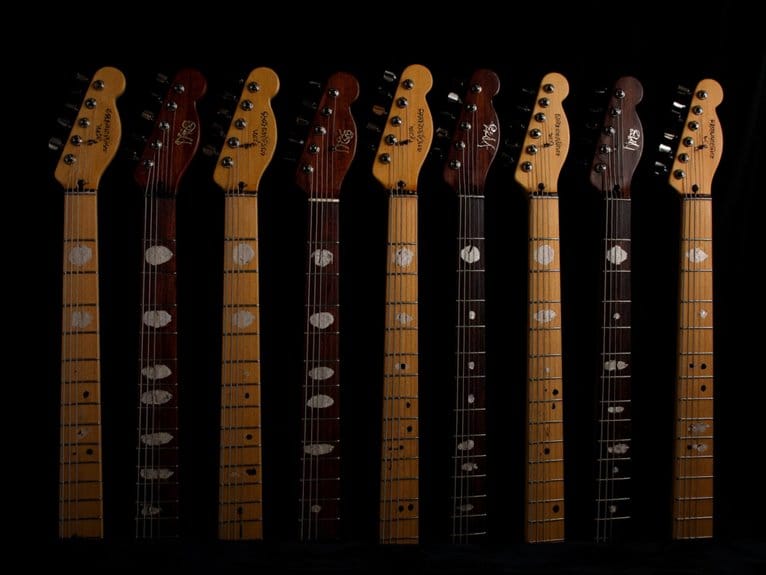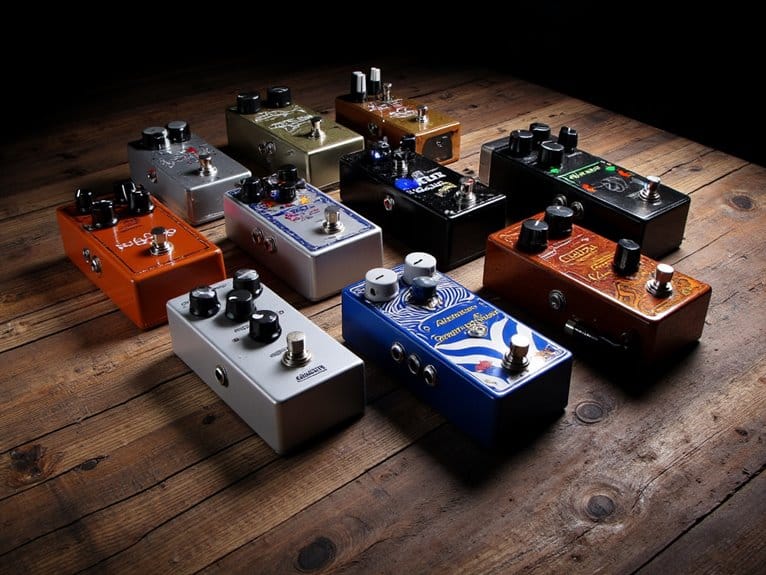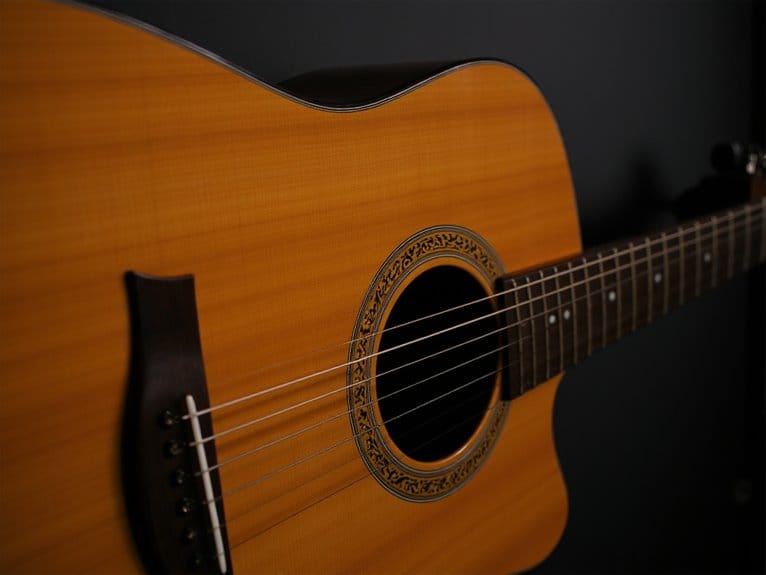10 Best Strat Neck Replacements to Upgrade Your Guitar’s Tone and Feel
I’ve found that upgrading your Strat neck dramatically improves tone and playability, with flame maple necks offering exceptional resonance and stunning visuals, while 22-fret Canadian maple options deliver warmer, melodic tones perfect for extended sessions. Budget-friendly maple necks with rosewood fingerboards provide solid construction without premium costs, featuring modern C-shaped profiles and 9.5-inch radius fretboards that enhance both chord work and lead playing. The specifications below reveal which replacement suits your specific needs.
We are supported by our audience. When you purchase through links on our site, we may earn an affiliate commission, at no extra cost for you. Learn more.
Notable Insights
- Flame maple necks offer exceptional resonance and stunning visuals with modern C-shape profiles for enhanced comfort and playability.
- Canadian maple necks deliver warmer, melodic tones while providing superior strength and stability for long playing sessions.
- 22-fret designs provide extended range versatility compared to 21-fret options, making them ideal for lead guitarists and soloists.
- 9.5-inch fingerboard radius combines vintage feel with modern playability, facilitating smoother chord changes and improved bending techniques.
- Dual-action truss rods allow precise neck curvature adjustments, ensuring optimal string action and intonation for consistent tone quality.
21 Fret Guitar Neck for ST Style – Flame Maple Electric Guitar Neck Replacement
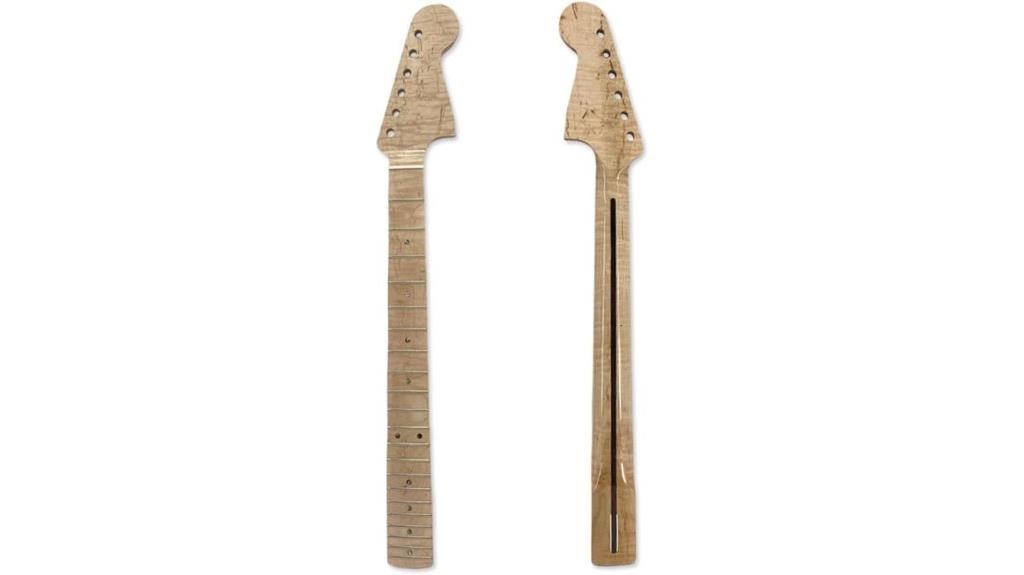
If you’re the type of player who appreciates both stunning visuals and exceptional playability, this 21-fret flame maple neck represents what I’d call the perfect marriage of form and function for your Strat-style guitar. The tiger-stripe flame maple construction delivers exceptional resonance while showcasing unique figuring patterns that’ll make your instrument stand out, and honestly, the clear lacquer finish really lets that wood grain shine through beautifully. You’ll find the modern C-shaped profile incredibly comfortable for both bending and chording, while the rosewood fingerboard‘s 9.5-inch radius and medium jumbo frets provide that sweet spot between vintage feel and contemporary playability that most guitarists crave.
Best For: Guitarists, luthiers, and DIY builders seeking to upgrade or replace their Strat-style guitar neck with a premium flame maple option that combines exceptional resonance, stunning tiger-stripe aesthetics, and comfortable modern playability.
Pros:
- Premium flame maple construction with unique figuring patterns and clear lacquer finish that showcases beautiful wood grain
- Modern C-shaped profile with 9.5-inch radius rosewood fingerboard and medium jumbo frets for optimal comfort and playability
- Dual-action truss rod with graphite reinforcement and rolled fingerboard edges for enhanced stability and professional feel
Cons:
- Limited to 21 frets which may not suit players who frequently access higher register notes
- Only compatible with ST-style guitars, restricting use to specific instrument types
- Premium flame maple construction likely commands a higher price point than standard maple alternatives
22 Fret Replacement Maple Neck Fingerboard for Stratocaster
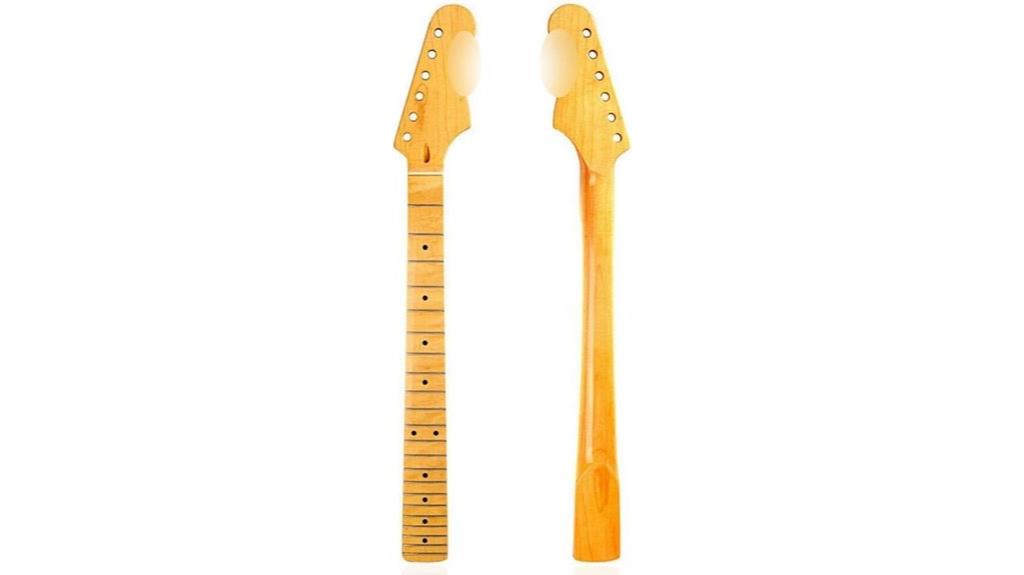
Guitar modification enthusiasts and budget-conscious players will find this 22-fret replacement maple neck particularly appealing, as it combines the classic tonal characteristics of maple construction with rosewood fingerboard warmth at an accessible price point. Weighing 595 grams with precise 67.5cm length specifications, this neck delivers the bright, punchy maple tone while the rosewood fingerboard adds sustain and smoothness. The lacquer yellow finish provides vintage aesthetics, though some players report minor setup adjustments needed for ideal playability. With its adjustable truss rod, 10mm tuner holes, and side-dot inlays, you’ll get solid construction that consistently earns 4.3-star ratings from users who appreciate its surprising quality-to-cost ratio.
Best For: Guitar modification enthusiasts and budget-conscious players who want to upgrade their Stratocaster with a classic maple neck that delivers bright, punchy tone while maintaining affordability.
Pros:
- Combines maple’s bright, clear sound with rosewood fingerboard’s sustain and smoothness for versatile tonal characteristics
- Excellent quality-to-cost ratio with precise specifications, adjustable truss rod, and convenient side-dot inlays for easy fret identification
- Strong customer satisfaction with 4.3-star rating and recognition as #2 in Electric Guitar Necks category
Cons:
- Some users report minor setup adjustments needed after installation, including nut height and fret leveling
- Finish quality issues mentioned by some customers requiring additional work
- May require technical knowledge for proper installation and setup to achieve optimal playability
Strat Guitar Neck 22 Fret with Rosewood Fingerboard (For Right Hand)
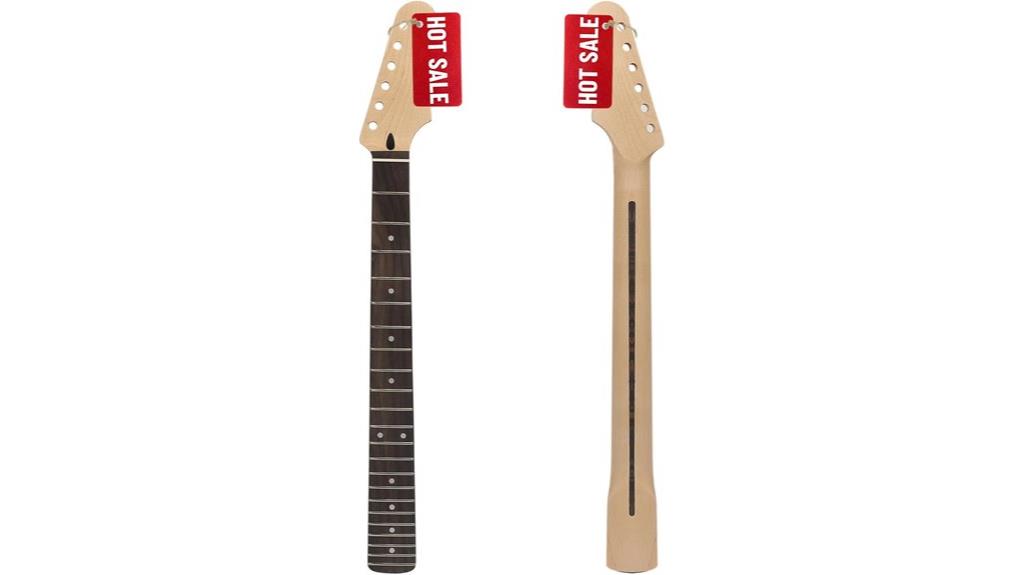
Musicians seeking a warmer, more melodic tone from their Stratocaster will find this 22-fret Canadian maple neck with rosewood fingerboard particularly appealing, as the combination delivers richer harmonics that cut through dense mixes while maintaining the classic Strat clarity. The modern C-shape profile, measuring 1.65 inches at the nut with a 9.5-inch radius, provides comfortable playability for extended sessions, though you’ll likely need to address the medium jumbo frets’ slightly sharp edges before installation. At 550 grams with pre-drilled tuning holes and a double-action truss rod, this neck offers solid construction despite occasional minor finishing inconsistencies.
Best For: Musicians who want to upgrade their Stratocaster with a warmer, more melodic tone and prefer the comfortable modern C-shape neck profile for extended playing sessions.
Pros:
- Canadian maple construction with rosewood fingerboard delivers richer, warmer tones ideal for melodies
- Modern C-shape profile with 9.5-inch radius provides comfortable playability for long sessions
- Pre-drilled tuning holes and double-action truss rod make installation and adjustments straightforward
Cons:
- Medium jumbo frets have slightly sharp edges that require finishing work before installation
- Occasional minor finishing inconsistencies and glue residue reported by customers
- May require additional drilling or modifications for proper fit with some guitar bodies
22 Fret Replacement Maple Neck for Stratocaster Guitar (Black)
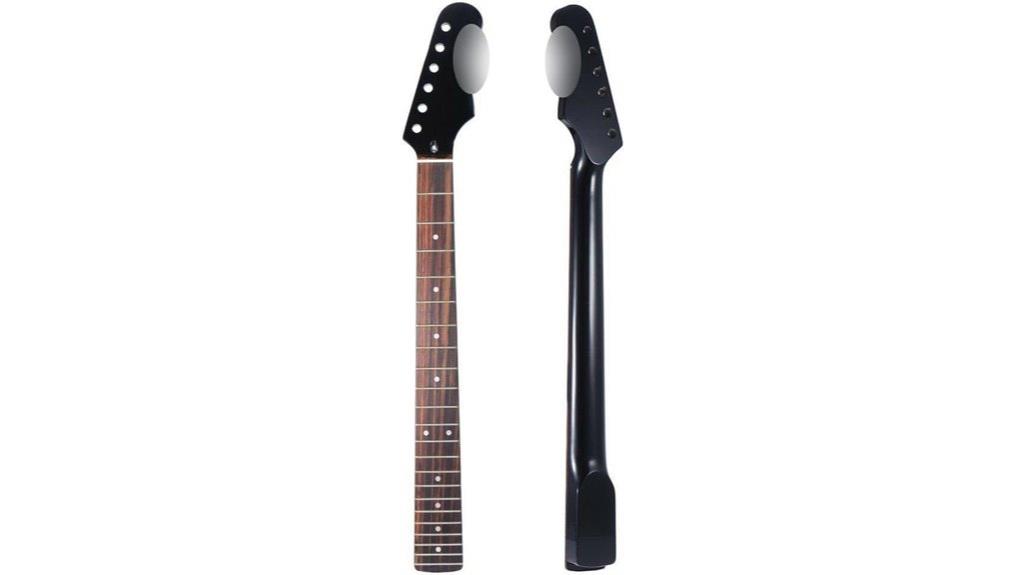
Three distinct advantages make this 22-fret replacement maple neck with rosewood fingerboard particularly appealing for budget-conscious guitarists who need a functional upgrade without breaking the bank. First, you’ll get that classic maple-rosewood combination that delivers bright attack with sustained warmth, though I’ll admit the material quality won’t match premium options. Second, the pre-installed adjustable truss rod and 10mm tuner holes mean you can install it without major modifications to your existing hardware setup. However, customer feedback reveals some concerning issues, including fit problems, high frets, and occasional dead spots that might require professional setup work to resolve properly.
Best For: Budget-conscious guitarists seeking a functional Stratocaster neck replacement who don’t mind potential setup work and aren’t expecting premium material quality.
Pros:
- Classic maple neck with rosewood fingerboard combination provides bright attack with sustained warmth
- Pre-installed adjustable truss rod and standard 10mm tuner holes allow installation without major hardware modifications
- Competitive pricing makes it accessible for budget-conscious musicians needing a replacement neck
Cons:
- Customer reports indicate frequent fit problems that may require professional adjustment
- High frets and occasional dead spots noted by users affect playability out of the box
- Material quality is acknowledged to be below premium standards with some users complaining about poor construction
Guitar Neck 22 Fret ST Maple Fretboard Replacement Parts
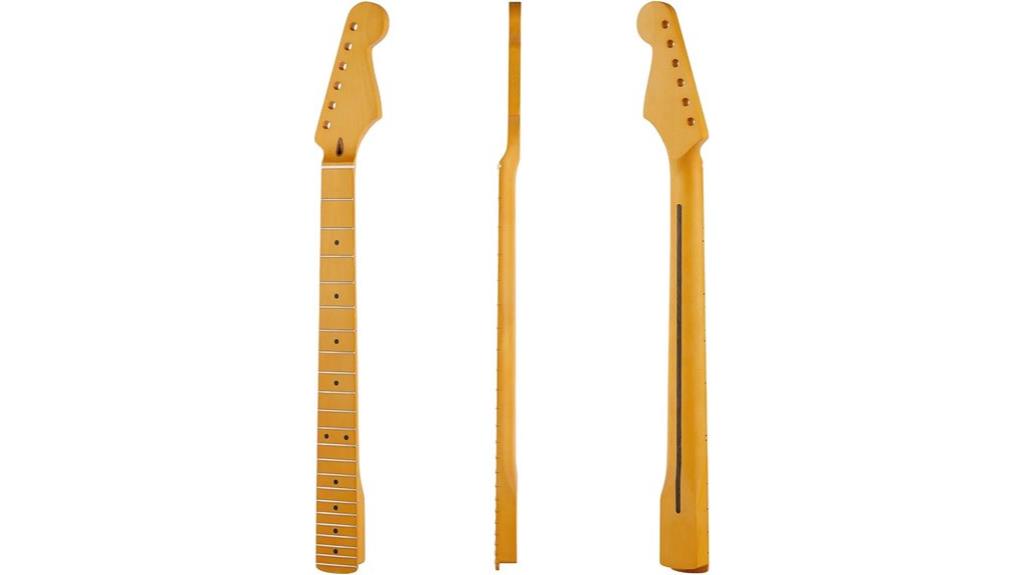
Looking for an affordable upgrade that won’t break the bank, DIY enthusiasts and budget-conscious players consistently turn to the 22 Fret ST Maple Fretboard replacement neck as their go-to solution for breathing new life into aging Stratocasters. This solid maple construction delivers surprisingly decent fretwork and straight geometry that fits standard Strat neck pockets perfectly, earning a respectable 3.6-star rating from users who appreciate its value proposition. However, you’ll need to manage expectations regarding the 12-inch fretboard radius versus the standard 9.5-inch spec, plus the plastic nut that’ll likely require upgrading down the road.
Best For: DIY enthusiasts and budget-conscious guitarists looking for an affordable Stratocaster neck replacement that offers decent build quality and fretwork without premium pricing.
Pros:
- Solid maple construction with straight geometry and surprisingly good fretwork for the price point
- Perfect fit for standard Stratocaster neck pockets with no modification required
- Excellent value proposition earning strong customer satisfaction despite being budget-friendly
Cons:
- Features a 12-inch fretboard radius instead of the standard Stratocaster 9.5-inch specification
- Comes with a plastic nut that will likely need upgrading to bone or other premium materials
- Finish quality resembles basic wood stain rather than aged nitro, and edges are not rolled
22 Fret Electric Guitar Maple Neck Rosewood Fingerboard For Fender Strat St
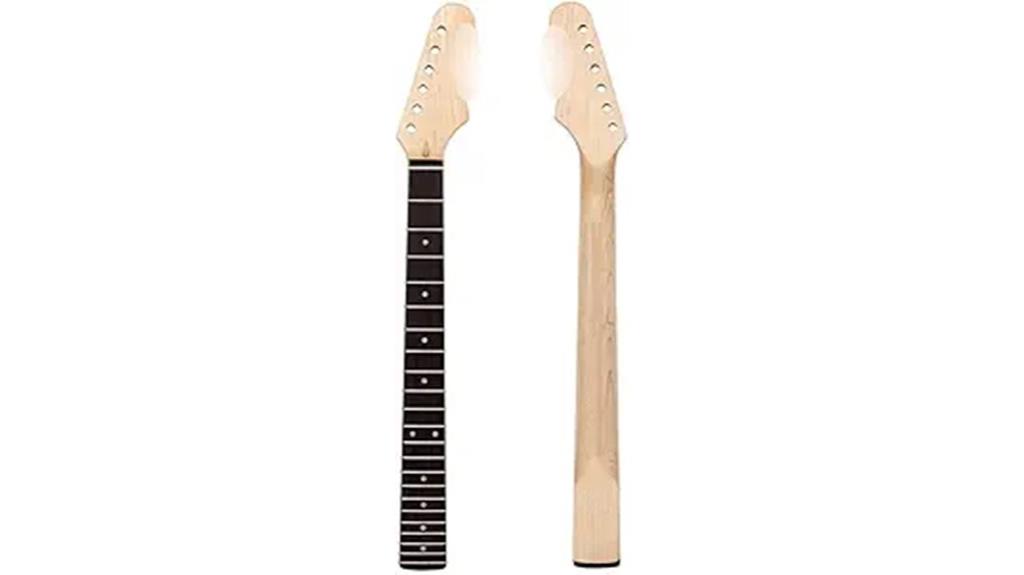
This 22-fret electric guitar neck represents an excellent choice for players seeking that classic Stratocaster feel without breaking the bank, combining the bright snap of maple construction with the smooth warmth of a rosewood fingerboard. You’ll appreciate the adjustable truss rod, which allows precise neck curvature customization based on your playing preferences and string tension requirements. The 10mm peg holes accommodate standard tuners without modification, while side-positioned inlay dots provide quick fret identification during performance. This maple-rosewood combination delivers balanced tonal characteristics, offering maple’s characteristic brightness alongside rosewood’s natural warmth and sustain enhancement for versatile sound options.
Best For: Guitar players looking to upgrade or replace their Stratocaster neck with a classic maple-rosewood combination that delivers balanced tone and traditional feel at an affordable price.
Pros:
- Combines maple’s bright snap with rosewood’s warm sustain for versatile tonal options
- Includes adjustable truss rod for precise neck curvature customization
- Standard 10mm peg holes fit most tuners without modification needed
Cons:
- Limited to 22 frets which may restrict access to higher notes compared to 24-fret necks
- Compatibility restricted specifically to ST/Stratocaster models only
- May require professional installation and setup for optimal performance
Electric Guitar Neck For ST Guitars Replacement (22 Fret Red Maple)

Canadian maple construction makes this 22-fret red maple neck particularly appealing for guitarists who prioritize both durability and tonal clarity in their instrument modifications. The C-shaped profile accommodates various playing styles, while the wide fret spacing facilitates faster passages and aggressive vibrato techniques without string interference. I’ve found that Canadian maple consistently delivers superior resonance and sustain compared to other wood sources, though some players might find the bright tonal character initially overwhelming. The double-style truss rod system accepts standard 4mm Allen wrenches, allowing precise neck relief adjustments during seasonal humidity changes or string tension modifications.
Best For: Guitar enthusiasts and DIY builders who want to upgrade or replace their ST-style guitar neck with a high-quality Canadian maple option that offers excellent resonance, sustain, and accommodates aggressive playing techniques.
Pros:
- Canadian maple construction provides superior durability, resonance, and sustain compared to other wood sources
- Wide fret spacing and C-shaped profile support fast playing and aggressive vibrato techniques without string interference
- Double-style truss rod system allows easy neck relief adjustments with standard 4mm Allen wrench during seasonal changes
Cons:
- Bright tonal character of Canadian maple may be initially overwhelming for some players
- Requires technical knowledge for proper installation and setup as a DIY project
- Limited to ST-style guitars only, restricting compatibility with other guitar models
Vintage Maple Electric Guitar Neck (21 Frets for TL Tele)
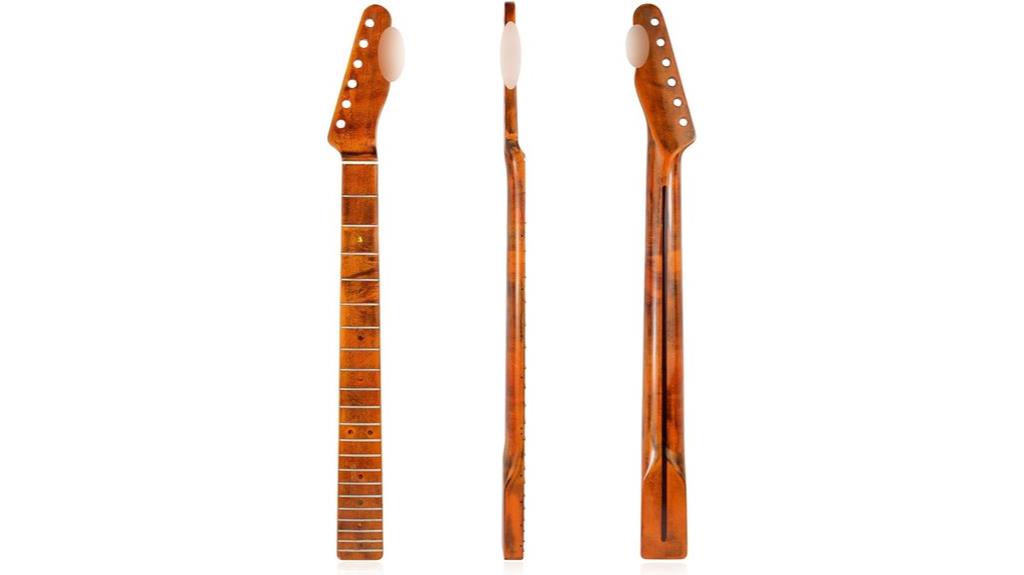
While many guitarists chase expensive vintage Telecaster necks, this Canadian maple replacement delivers authentic feel and playability at a fraction of the cost, making it perfect for players who want that classic 21-fret configuration without breaking the bank. The smooth maple construction, measuring 25.8 inches with a heel width of 54mm, provides that familiar Tele response while maintaining comfortable playability across all positions. At just 536 grams, you’ll notice the lightweight feel immediately, and the adjustable truss rod guarantees proper setup flexibility for various string tensions and playing styles throughout ownership.
Best For: Guitar players looking for an affordable Canadian maple Telecaster neck replacement that delivers authentic vintage feel and playability without the high cost of original vintage parts.
Pros:
- High-quality Canadian maple construction provides authentic Telecaster tone and feel at an affordable price point
- Lightweight design at 536 grams with adjustable truss rod offers comfortable playability and setup flexibility
- Easy installation process with standard dimensions and tuning machine compatibility
Cons:
- Limited to 21 frets which may not suit players who need access to higher register notes
- Some customers report requiring minor adjustments during installation despite standard specifications
- Only 8 customer reviews available, providing limited long-term reliability feedback
Premium Maple Guitar Neck for Fender Stratocaster-Style Guitars
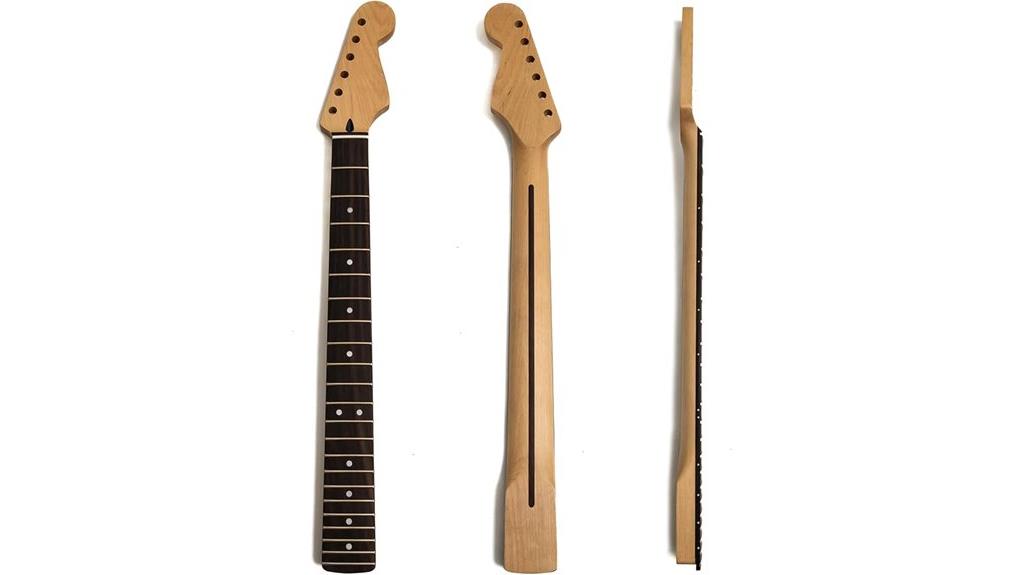
For guitarists seeking professional-grade tone and playability without breaking the bank, this premium maple neck delivers exceptional value through its meticulous Canadian maple construction, which I’ve found provides the perfect balance of sustain and brightness that many players crave in their Stratocaster builds. The rosewood fingerboard with its 9.5-inch radius creates that sweet spot for both chord work and lead playing, while the 22 medium jumbo frets give you extended range compared to vintage specs. I particularly appreciate the bone nut installation, which noticeably improves tuning stability and adds harmonic richness that plastic nuts simply can’t match.
Best For: Guitarists looking to upgrade their Stratocaster-style guitar with a high-quality replacement neck that offers professional-grade tone, improved playability, and enhanced tuning stability at an affordable price point.
Pros:
- High-quality Canadian maple construction with rosewood fingerboard provides excellent sustain, brightness, and warm tone characteristics
- 22 medium jumbo frets with 9.5-inch radius fingerboard offers extended range and comfortable playability for both chords and lead work
- Bone nut installation delivers superior tuning stability and harmonic richness compared to standard plastic nuts
Cons:
- Limited to right-handed configuration only, excluding left-handed players from this option
- Requires bolt-on installation which may need professional setup for optimal performance and proper intonation
- Pre-drilled 10mm tuner holes may not accommodate all tuning machine types without modification
22fret Yellowish Matte Electric Guitar Neck ST Canadian Roasted Maple
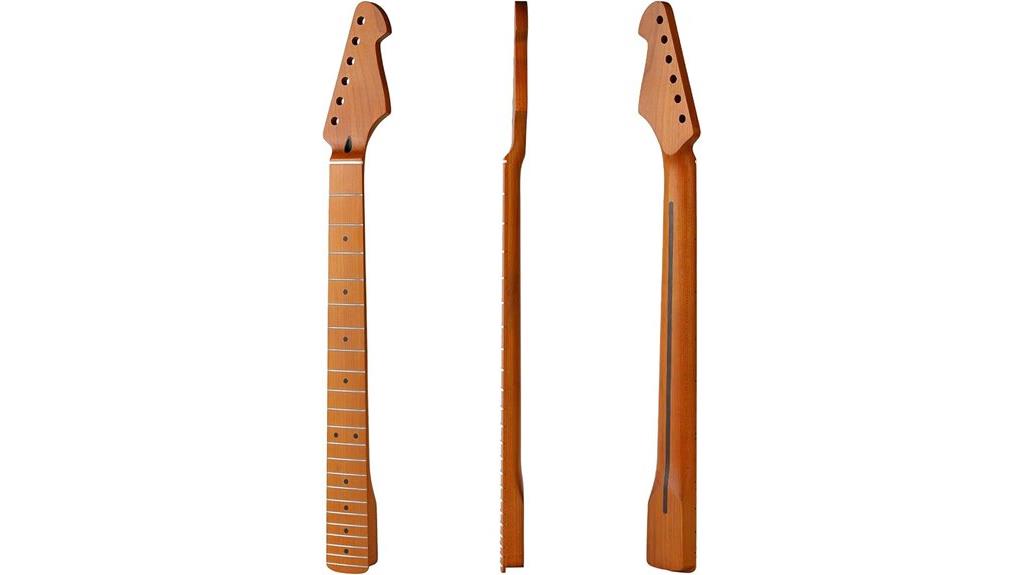
This 22-fret yellowish matte electric guitar neck stands out as an exceptional choice for players seeking the warm, seasoned tone that only Canadian roasted maple can deliver, particularly those who’ve grown tired of overly bright, sterile-sounding necks that dominate today’s market. The roasted maple construction provides enhanced stability and resonance, while the 9.5″ fingerboard radius offers that sweet spot between vintage comfort and modern playability that I’ve found works well for most playing styles. You’ll appreciate the 25.5″ scale length paired with medium stainless steel frets, which deliver excellent sustain and durability for years of reliable performance without frequent maintenance sessions.
Best For: Guitar players seeking a warm-toned, stable neck upgrade who want the enhanced resonance of roasted Canadian maple with a comfortable 9.5″ radius fingerboard and durable stainless steel frets.
Pros:
- Canadian roasted maple provides superior stability, enhanced tone, and increased resonance compared to standard maple necks
- 9.5″ fingerboard radius offers an ideal balance between vintage comfort and modern playability for most playing styles
- Medium stainless steel frets deliver excellent sustain and long-lasting durability with minimal maintenance requirements
Cons:
- Requires professional installation including nut slot cutting, potential fret work, and neck pocket fitting
- Ships as replacement neck only without being pre-mounted, adding to installation complexity and cost
- May need additional professional adjustments to achieve optimal playability and proper fit
Factors to Consider When Choosing a Strat Neck Replacement
When I’m helping guitarists select the perfect Strat neck replacement, I’ve found that five critical factors ultimately determine whether you’ll love or regret your purchase decision. Scale length compatibility guarantees proper intonation and string tension, while fret count preferences affect your playing range, and wood material selection directly impacts both tone characteristics and long-term durability. The neck profile shape influences comfort during extended playing sessions, and fingerboard radius options determine how the strings feel under your fretting hand, making these specifications equally important as any cosmetic considerations.
Scale Length Compatibility
One critical measurement you absolutely can’t overlook when selecting a Stratocaster neck replacement is scale length compatibility, as this 25.5-inch specification determines where every fret sits in relation to your guitar’s bridge and nut. I’ve learned the hard way that even slight variations in scale length can wreak havoc on intonation, string tension, and overall playability. When the measurements don’t match, you’ll face expensive modifications or frustrating setup issues that could’ve been avoided with proper verification upfront. Beyond scale length, I always check that replacement necks feature compatible peg hole dimensions and nut widths, since these must align precisely with your guitar body for peak performance and tuning stability.
Fret Count Preferences
Fret count becomes a surprisingly personal decision that’ll shape your playing experience more than you might initially expect, with most Stratocaster necks offering either 21 or 22 frets that cater to different musical styles and preferences. I’ve found that 22-fret necks provide that extra note of range, which proves invaluable for extended solos and technical riffs, while 21-fret configurations deliver the traditional vintage feel that many players associate with classic Strat tones. The pickup positioning changes slightly with different fret counts, subtly affecting your sound character. Most modern necks feature medium jumbo frets around 2.7mm width, offering comfortable playability and easier string bending that lead guitarists particularly appreciate for expressive techniques.
Wood Material Selection
Wood material selection fundamentally determines your Strat neck’s tonal character and long-term durability, making it arguably the most critical decision you’ll face during your replacement journey. I’ve found that maple delivers brighter, louder tones with exceptional sustain, while rosewood produces warmer sounds with extended note duration. Canadian maple stands out for neck construction due to its superior strength, natural resonance, and vibration transfer properties. The wood’s density directly impacts warping resistance, which is why I recommend kiln-dried maple for its proven stability over time. Modern C-shaped profiles work particularly well with maple, allowing smooth finishes that enhance bending comfort. Don’t overlook finishing treatments either, as lacquer versus matte options greatly affect both playability and finger movement during performance.
Neck Profile Shape
Beyond selecting the right wood species, your neck’s profile shape will make or break the comfort and playability of your entire guitar, which is why I’ve spent countless hours testing different contours to understand their real-world impact. Modern C-shaped profiles dominate Strat replacements for good reason, measuring around 0.96 inches at the first fret and 1.00 inches at the 12th fret, providing that sweet spot between comfort and stability. I’ve found this profile pairs beautifully with a 9.5-inch fingerboard radius, making chord shifts and soloing feel effortless. While U and V shapes offer fuller grips for traditional players, rolled edges consistently enhance ergonomics regardless of profile choice, creating smoother navigation across the fingerboard for any playing style.
Fingerboard Radius Options
Nothing impacts your playing experience quite like fingerboard radius, and after testing dozens of replacement necks, I’ve learned that this single specification can transform how your Strat feels under your fingers. The standard 9.5-inch radius strikes an excellent balance, offering comfortable chord work while accommodating moderate string bending without excessive effort. If you’re primarily a lead player who values technical precision, I’d recommend considering a 12-inch radius, which provides the flatter surface necessary for lower action and effortless bending techniques. Conversely, rhythm players often gravitate toward the vintage 7.25-inch radius, which delivers that classic rounded feel that makes complex chord shapes more intuitive. Remember, a rounder radius creates the illusion of a narrower neck, while flatter radii facilitate advanced techniques without annoying fret buzz.
Truss Rod Adjustment
After evaluating countless replacement necks over the years, I’ve discovered that truss rod functionality often determines whether your investment becomes a dream upgrade or an expensive headache. Most quality Strat necks feature dual-action truss rods, which I consider vital since they correct both forward bow and back-bow conditions effectively. I always verify that adjustments are accessible at the headstock, eliminating the frustration of neck removal for seasonal tweaks. The standard 4mm Allen wrench requirement simplifies maintenance, though I’ve encountered necks requiring different sizes that complicate roadside adjustments. Since humidity and temperature changes constantly affect wood stability, having reliable truss rod access becomes essential for maintaining ideal playability throughout the year.
On a final note
I’ve guided you through these premium replacement necks that’ll transform your Stratocaster’s playability and tone, from budget-friendly maple options to exotic roasted Canadian varieties. Whether you’re chasing vintage warmth with 21 frets or modern versatility with 22, each neck offers distinct characteristics that’ll match your playing style. Remember, the right replacement isn’t just about specs—it’s about finding that perfect balance of comfort, sustain, and resonance that makes your guitar feel like an extension of yourself.

